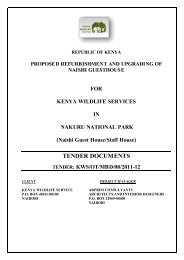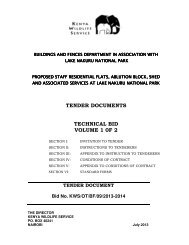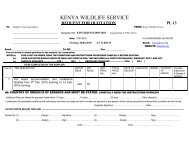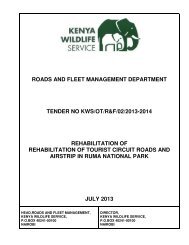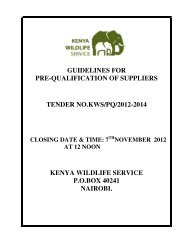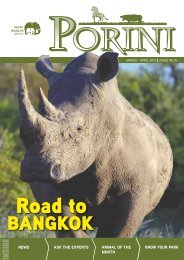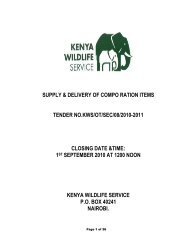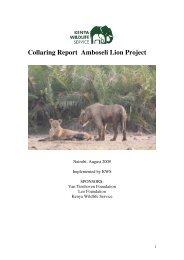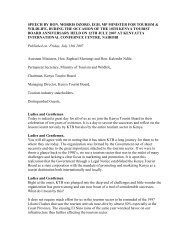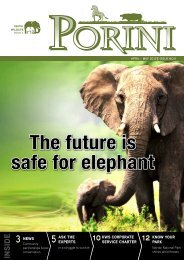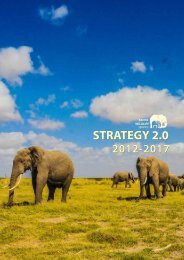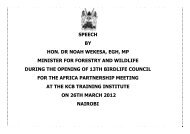Conservation and Management Strategy for the Elephant in Kenya
Conservation and Management Strategy for the Elephant in Kenya
Conservation and Management Strategy for the Elephant in Kenya
Create successful ePaper yourself
Turn your PDF publications into a flip-book with our unique Google optimized e-Paper software.
vii<br />
LIST OF FIGURES<br />
LIST OF TABLES<br />
Figure 1:<br />
Figure 2:<br />
Figure 3:<br />
Figure 4:<br />
Figure 5:<br />
Figure 6:<br />
xxv, Plan-at-a-glance structure of <strong>the</strong><br />
2011-2020 <strong>Elephant</strong> <strong>Conservation</strong> <strong>and</strong><br />
<strong>Management</strong> <strong>Strategy</strong>.<br />
Page 7, Total estimates <strong>for</strong> elephant numbers<br />
<strong>in</strong> <strong>Kenya</strong> <strong>in</strong> different reliability categories<br />
1995–2006 ((Af ESG reports). KWS– <strong>in</strong>ternal<br />
estimates <strong>in</strong>dicate that <strong>the</strong>re are about 35,000<br />
elephants <strong>in</strong> <strong>the</strong> country <strong>in</strong> 2010 (not verified<br />
by Af ESG at date of publication).<br />
Page 8, Total counts Tsavo (1988-2008).<br />
Page 8, Known population Amboseli<br />
(1979-2007).<br />
Page 8, Total counts Meru (1990-2006).<br />
Page 8, Total counts Mara (1984-2007).<br />
Table 1:<br />
Table 2:<br />
Table 3:<br />
Table 4:<br />
Table 5:<br />
Page 4-5, Summary of elephant population<br />
estimates from 1995 to 2006 (from Af ESG<br />
reports, data rearranged by KWS <strong>Conservation</strong><br />
Areas).<br />
Page 6, Summary of <strong>the</strong> most up-to-date<br />
elephant population estimates (from KWS).<br />
Page 11, Areas of elephant range <strong>in</strong> <strong>Kenya</strong>,<br />
surveyed/assessed <strong>and</strong> un-assessed, <strong>in</strong> Known<br />
<strong>and</strong> Possible Categories (from Af ESG reports).<br />
Page 25, Threat categories - poach<strong>in</strong>g/illegal<br />
kill<strong>in</strong>g <strong>and</strong> habitat degradation.<br />
Page 27-28, Threat categories - habitat loss,<br />
fragmentation, encroachment, poor l<strong>and</strong> use<br />
policy, negative attitudes, climate uncerta<strong>in</strong>ty,<br />
<strong>in</strong>security <strong>and</strong> <strong>in</strong>adequate resources.<br />
Figure 7:<br />
Figure 8:<br />
Figure 9:<br />
Figure 10:<br />
Figure 11:<br />
Figure 12:<br />
Page 8, Total counts Samburu/Laikipia<br />
(1992-2008).<br />
Page 9, The proportion of illegally killed<br />
elephants (PIKE; dark portion of columns)<br />
contrasted with o<strong>the</strong>r causes of elephant<br />
mortality (white portion of columns).<br />
Page 10, The proportion of illegally killed<br />
elephants through poach<strong>in</strong>g (dark portion<br />
of columns) contrasted with illegally killed<br />
elephants through HEC (white portion of<br />
columns).<br />
Page 10, The proportion of illegally killed<br />
elephants (PIKE; dark portion of columns)<br />
contrasted with o<strong>the</strong>r causes of elephant<br />
mortality (white portion of columns) <strong>in</strong><br />
different regions of <strong>Kenya</strong> over <strong>the</strong> period<br />
2000-2009. Western <strong>and</strong> Eastern regions were<br />
excluded as <strong>the</strong>y had <strong>in</strong>complete dataset.<br />
Page 13, Map of elephant range <strong>in</strong> <strong>Kenya</strong> as of<br />
2006, from African <strong>Elephant</strong> Status Report<br />
(Blanc et al., 2007). Boundaries of KWS<br />
<strong>Conservation</strong> Areas have been added.<br />
Page 24, Recovered ivory by <strong>Kenya</strong> Wildlife<br />
Service armed w<strong>in</strong>g.<br />
Table 6:<br />
Table 7:<br />
Table 8:<br />
Table 9:<br />
Table 10:<br />
Table 11:<br />
Table 12:<br />
Table 13:<br />
Page 30, Threat categories - habitat change<br />
<strong>and</strong> loss of resilience <strong>in</strong> wild rangel<strong>and</strong>s <strong>and</strong><br />
<strong>in</strong>adequate benefits from l<strong>and</strong> use <strong>and</strong> elephant.<br />
Page 38-39, Protection strategic objective targets,<br />
actions, timel<strong>in</strong>es, actors <strong>and</strong> <strong>in</strong>dicators<br />
Page 42-43, Population Expansion <strong>and</strong> Habitat<br />
<strong>Management</strong> strategic objective targets, actions,<br />
timel<strong>in</strong>es, actors <strong>and</strong> <strong>in</strong>dicators<br />
Page 45-47, Research <strong>and</strong> Monitor<strong>in</strong>g <strong>for</strong><br />
<strong>Management</strong> strategic objective targets, actions,<br />
timel<strong>in</strong>es, actors <strong>and</strong> <strong>in</strong>dicators<br />
Page 49-51, Human <strong>Elephant</strong> Conflict strategic<br />
objective targets, actions, timel<strong>in</strong>es, actors <strong>and</strong><br />
<strong>in</strong>dicators<br />
Page 53-55, Incentives strategic objective targets,<br />
actions, timel<strong>in</strong>es, actors <strong>and</strong> <strong>in</strong>dicators<br />
Page 57-58, Capacity strategic objective targets,<br />
actions, timel<strong>in</strong>es, actors <strong>and</strong> <strong>in</strong>dicators<br />
Page 60-62, Coord<strong>in</strong>ation <strong>and</strong> Support strategic<br />
objective targets, actions, timel<strong>in</strong>es, actors <strong>and</strong><br />
<strong>in</strong>dicators<br />
Figure 13:<br />
Page 26, Human-wildlife conflict hotspots.<br />
Figure 14:<br />
Figure 15:<br />
Page 26, The elephant is <strong>the</strong> most significant<br />
conflict species <strong>in</strong> <strong>Kenya</strong> <strong>and</strong> causes <strong>the</strong><br />
greatest number of conflict cases.<br />
Page 26, Protective <strong>and</strong> productive Beehive<br />
Fences Lucy K<strong>in</strong>g, Save <strong>the</strong> <strong>Elephant</strong>s.<br />
Figure 16:<br />
Page 26, Chilli based elephant deterrent trials.<br />
Figure 17:<br />
Figure 18:<br />
Page 31, <strong>Elephant</strong>s are an essential draw <strong>for</strong><br />
tourism<br />
Page 60, The susta<strong>in</strong>ed framework <strong>for</strong> decision<br />
mak<strong>in</strong>g <strong>and</strong> <strong>in</strong><strong>for</strong>mation flow through area<br />
level committees to national committees with<br />
<strong>in</strong>volvement of all elephant stakeholders.



